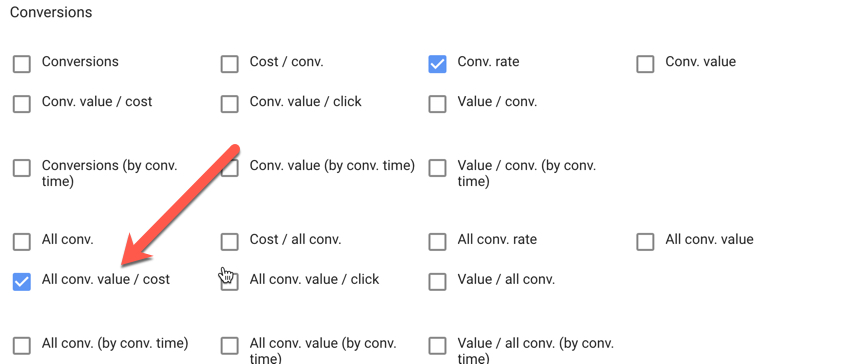“Am I profitable?”
It’s a question every PPC account manager is asked, but it’s also a question many account managers struggle with answering.
PPC marketers aren’t necessarily statistics wizards or mathematically oriented by nature, and there can be many factors that affect overall profitability.
While understanding Google Ads and the auction process at a deep technical level is crucial to the success of any campaign, understanding a business’ financial metrics is just as important – and it’s increasingly becoming more so.
Gone are the days where PPC was really the only place to put your money.
Now there is Microsoft Ads, Facebook Ads, Snapchat, Instagram, and the list goes on and on.
Money is diversified to many places, and there’s no silver bullet for attributing every dollar spent.
The best we can do is use some math as our guiding light.
Grasping the financial metrics will make you a better media buyer, and give you better results long-term, whether you’re in-house or agency side.
These calculations can feel daunting for some managers, but mastering these will put you miles ahead of most PPC managers in both knowledge and practice.
1. Determining ROAS
People interchange ROAS and ROI often, but they are not actually the same thing.
The difference between ROAS (return on ad spend) and ROI (return on investment) is whether you account for a company’s cost of doing business (often referred to as COGS – cost of goods sold – or profit margin).
When you talk about ROAS, you’re looking at PPC profitability in a linear way.
You are answering the question: did we make back more money in revenue than we spent on ads?
When you talk about ROI, you’re looking at your PPC spend in a multidimensional way.
ROI tries to answer this question:
After accounting for the costs of the products or service, and after accounting for the cost of advertising, did we make a profit?
In this example, let’s say you sell shoes for $50 a pair. Your ROAS would use the $50 in its calculation.
But, pretend you have a 50% markup on those shoes. That means your total gross profit is actually only $25.
Big difference!
Generally, media buyers rely on ROAS, because they don’t have all the internal calculations feeding into Google Ads that would show them ROI.
What You Need to Determine ROAS
- Total Conversion Value
- Total Cost of Advertising
Formula to Use
Total Conversion Value / Total Cost of Advertising
Example
A client runs a lead gen website that sells its leads to attorneys throughout the United States. The client asks you what their return on ad spend has been over the past 30 days.
They spent $17,547 on their Google Ads campaigns which brought in 489 leads.
Of those, 375 of those leads were sold to attorneys. They paid an average of $130 a lead.
This means their conversion value was $48,750 ($130 a lead x 375 leads)
The ROAS would be 2.78 or 278% (48,750 total value / 17,547 Google Ads cost)
You can report back to the client that ROAS for the past 30 days was 278%.
Put another way, for every dollar spent on advertising they made back $2.78.
Tip
Google Ads actually has a column specifically built for ROAS.
Except Google doesn’t call it ROAS, so you might pass right on by it.
It’s labeled as All conv. value / cost.

If your campaigns are accurately tracking conversion value then you can use this column to calculate your ROAS quickly.
If a site isn’t ecommerce, that means you probably aren’t tracking conversion values for each conversion inside the account.
You’ll need to calculate ROAS by hand using the information your client gives you.
If every conversion is worth the same amount, you can instead assign that value to a conversion type, which would allow you to use that column.
2. Determining Break-Even ROAS
ROAS is nice and all, but it doesn’t give you the full profitability picture.
As you saw previously in our shoe example, products cost money to the retailer.
Just knowing your ROAS doesn’t tell you if you are making or losing money overall.
For example, you can have a client whose ROAS is a whopping 400%, but they’re still losing money once you calculate their profit margins.
As a PPC account manager, it’s important to first set a break-even ROAS for your clients.
Every client will calculate profit margins differently (do we include rent in our profit margins calculations or do we not include rent, for example), but determining a basic profit margin is the first step in determining your client’s break-even ROAS.
What You Need to Determine Break-Even ROAS
- Profit Margin
Formula to Use
1 / Profit Margin
Example
Let’s say you’re a travel agent that books first class and business class airfare.
Each ticket booked generates an average of $1,600 in revenue.
That’s before the ticket is paid for, though.
About 65% of that revenue goes to the cost of booking the ticket and 6% of the revenue is paid out to salespeople for commission.
First, subtract the cost of the actual ticket. This would be 65% of $1,600, which is $1,040. Subtract that from the $1600 in revenue, and revenue is now down to $560.
Then there’s the 6% for the salesperson, which is 6% of $1,600. That’s another $96, leaving revenue at $464.
Out of the $1,600 in revenue, your client makes a profit of $464.
In essence, your profit margin would then be 29%.
But that’s not the whole picture.
This calculation of profit margin doesn’t include potential costs of doing business like rent, taxes, and other overhead.
And if you’re an agency, it’s not accounting for the cost of you!
This is simply the cost of servicing the booked airfare.
So to calculate your break-even ROAS you simply divide 1 by your profit margin.
1 / .29 = 3.4 (or 340%)
In other words, you need to make $3.40 for every dollar spent on advertising.
To explain break-even ROAS in a non-mathematical way:
To make a $1 of profit, you need to generate $3.40 of revenue ($1 is 29% of $3.40). You then subtract the $1 spent on advertising and you break even.
In our above scenario, anything over 340% ROAS, means you are making money.
If it’s less 340% ROAS, you’re losing it.
Tip
Some businesses hyper-focus on linear profitability (making more money than they spend after accounting for profit margins).
This can be short-term thinking if their customers tend to produce lifetime value to the business.
For example:
- Do customers come back and buy again?
- Do customers typically refer friends?
- Is it a subscription service with a monthly fee, and there’s an average span of subscription time?
Determining the average lifetime value of a client or customer can increase your profit margins and in turn decrease your break-even ROAS.
3. Determining Cost Per Conversion for Forms
Many accounts track form submissions as a conversion action in your client’s PPC accounts.
However, attributing a value per conversion is tricky since some form submissions don’t represent any profit or revenue for your client, or the amounts can vary drastically.
As a PPC manager, you want to know what your true cost per conversion is.
In other words, how much you pay for a form submission that turns into a sale or a deal or whatever it is that makes the business money.
What You Need to Determine CPA for Forms
- Average cost per conversion (cost per form submission)
- Average Form conversion rate (the percentage of forms that turn into sales)
Formula to Use
Avg. cost per conversion in Google Ads / Form conversion Rate
Example
Let’s use our travel agent example from the previous formula, but you are tracking form submissions as a conversion action.
You know that your average cost per conversion for your Google Ads is $37.
In other words, you’re generating form submissions at $37 a pop.
You close about 15% of all the forms received through Google Ads.
$37 cost per lead / .15 close rate = $246.67
So, your true average cost per conversion is $246.67, based on that close rate of 15%.
Now, we can calculate your ROI based on the numbers we have above.
Using the calculation for ROI means (profit – cost) / cost.
The numbers work out like this:
[($464 (average profit per conversion we calculated before) – $246.67 (true cost per conversion we just calculated)]/ $246.67 = 0.88.
Ultimately, you are making 88 cents for every dollar spent on advertising.
It may look like that’s a loss, but remember, they are not losing money (ROI could be a negative number).
They are making $0.88 on every dollar which can also be referred to as a 188% ROI (making back $1.88 for every dollar spent on advertising).
Tip
Now that you know what you’re really paying per conversion, you can identify areas to increase ROI.
For example, increasing the sales team’s conversion rate by a given percentage will decrease their cost per conversion by ‘x’ dollars.
4. Determining Break-Even CPA for Forms
We were able to calculate the break-even points for ROAS, but what about in our recent example tied to form submission?
Continuing our conversation from above, you know you’re profitable and that you’re generating sales at a $246.67 CPA.
But how do you know the most you can spend on a form submission without losing money?
Based on your close rate of 15%, you know a $37 cost per conversion in your ads is profitable.
But what if you were generating conversions at $42? Would the account still be making money?
Granted, you can plug those numbers into formula #3 — but there’s a better way.
What to Use to Calculate Break-Even CPA for Forms
- Average profit per sale
- Form conversion rate
Formula to Use
Average profit per sale x Form conversion rate
Example
As we saw above, our average profit per sale is $464 (after subtracting costs for commissions and the cost of booking the airfare).
We also know that 15% of forms close as a sale.
$464 profit x 0.15 close rate = $69.60
In plain English, you can pay up to $69.60 per form submission on average before you start losing money.
Tip
Sometimes it’s important to test decreasing profit margins for the sake of increasing volume and acquiring more clients.
Instead of thinking of it as:
“We’re generating form submissions at $37 per form.
The only way we could get more forms is if we increase our max CPC bids, raise our average position, buy more clicks, and generate forms for $45-$50.”
Think through this scenario:
“We’re generating form submissions at $37 per form.
At that rate, our ROI is 180%.
But, if we increase our bids, we could generate 20% more form submissions at $45 per form.
Our ROI would drop to 154% but it still gives us a nice cushion below our $69.60 CPA break-even point with higher volume.”
5. Determining Break-Even CPA for Complex Sales Cycles
Not all businesses convert their visitors in one linear process.
Long sales cycles can mean multiple touchpoints with a lead or prospect before closing a deal and generating revenue.
For this formula, let’s draw out the scenario first and then figure out the correct formula.
Let’s say you work for a company that sells a monthly subscription to a cloud-based small business accounting software.
Their average customer generates $3,287 over the course of the average subscription length.
Your PPC campaign sends traffic to a landing page promoting a free webinar that explains the benefits and features of the software.
But, uh-oh:
Webinar registrations are as far as your PPC conversion tracking goes!
This is where it’s crucial to know how your sales funnel generally performs.
45% of webinar registrants actually attend the free webinar.
Of those attendees, 15% ultimately sign up for a subscription to your client’s software.
Now you need to work backward on the math to figure out the most you should be paying for a webinar registration from your PPC campaigns.
What You Need to Know to Determine Your Break-Even CPA
- Average profit per sale
- Webinar conversion rate (percentage of registrants that attend)
- Sales conversion rate (percentage of attendees that buy a subscription)
Formula to Use
(Webinar Conversion Rate x Sales Conversion Rate) x Average Profit Per Sale
The first step in the formula determines our true, or actual conversion rate.
Because the conversion funnel is a two-step process, and not all leads go all the way through both steps, we need to multiply the two conversion rates together.
Once we have our true conversion rate, we simply borrow our formula from step 4 and multiply our average profit by our true conversion rate.
Let’s work through the math in our scenario:
(45% of registrants attend x 15% convert to subscribers) x $3,287 lifetime value of a sale = $221.87
Put simply, your break-even CPA for a webinar registrant is $221.87.
Tip
Explaining these calculations might feel a little overwhelming, but it can be easier if you walk through it with an example.
Here’s how you’d do it for a scenario where you generated 500 webinar attendees at a break-even CPA of $221.87:
- We generated 500 webinar registrants at an average cost per registrant of $221.87. In total, we spent $110,935.
- Of those 500 registrants, we expect 225 of them to actually attend the webinar, based on our historic average of 45%.
- Of those 225 attendees, we expect approximately 34 (15%) of them to buy a software subscription.
- We know that an average customer represents $3,287 in profit.
- If we multiply 34 sales by $3,287 in profit, we get a total profit of $111,758, just about breaking even on our advertising spend.
The above calculation can get more complicated if you don’t know the average lifetime value of a client.
We called it $3,287 just for the sake of this example, but sometimes it isn’t that straightforward.
Work to figure out these numbers so you’ll have a clearer sense of what’s going on, which will empower you to manage a more statistically accurate campaign.
Conclusion
Knowing how to calculate these formulas by heart is great.
But being able to explain how they make sense with scenario-based, non-mathematical English is way more important
If the “why” of these formulas makes sense to you, you’ll be able to apply them in different situations no matter what types of accounts you manage now and in the future.
It takes you beyond being a PPC manager and operating as a true partner to the success of a business.
More Resources:
- PPC 101: A Complete Guide to PPC Marketing Basics
- How to Measure Success in PPC Campaigns With & Without Conversion Data
- Which PPC Metrics Should You Focus On?
Image Credits
Screenshot taken by author, September 2020





